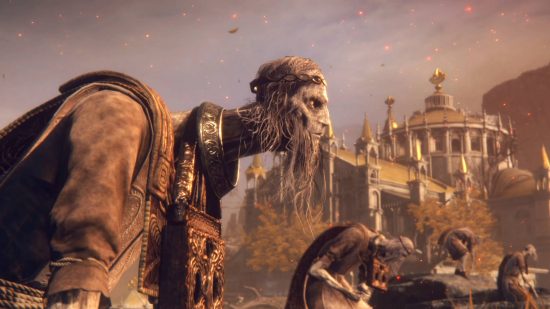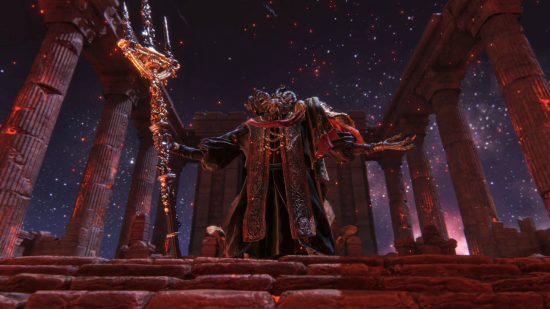Elden Ring is more than just a brilliant open-world game – it heralds a renaissance for the genre. For decades, devs’ approach to this genre has been to add detail – to craft a perfect universe where players can explore wherever they want, and this ‘more is more’ approach meets with varying degrees of success. For every Grand Theft Auto city packed with missions, shops, golf courses, and bowling alleys, or for every Elder Scrolls region stuffed with dungeons to explore, there are bland interpretations of real-world locations that may get the details right but wind up feeling dull and puffy.
Of course, the most obvious punching bags are any of the recent Ubisoft open-world games. It makes sense for almost every Assassin’s Creed to have an open world as they’re set in real-world locations from history, but Ubisoft has stuck open worlds (or very big maps) on many of its other series with mixed results. Far Cry, Watch Dogs, and Tom Clancy’s Ghost Recon all have huge islands or cities to explore, but not a lot in them besides millions of meaningless collectibles that eventually give you an achievement.
Even the post-reboot Assassin’s Creed games, which are easily Ubi’s most successful open worlds, get plenty of stick from some corners for feeling like less exciting imitations of Rockstar’s greats. It’s an oft-mocked trope for Ubisoft games and one the developer is, thankfully, making strides away from.

As such, 2022 did not see a new Ubisoft open-world adventure to compare, but plenty of other developers had a go. Elden Ring has earned all the praise, but the same couldn’t be said of the reboot of Saints Row, which failed to make much of an impact, as did Gotham Knights later in the year. Both these games are perfect examples of the failure of the ‘more is more’ approach: the devs tried to make maximalist open worlds, and instead we got dull cities with barely anything of note to do in them. Sonic Frontiers managed to fare a bit better, despite being the first time the blue hedgehog has had a fully open world to explore, but it still felt at times like a characterless void filled with collectibles and not much else.
Elden Ring is the groundbreaking exception. By using the features that define games like Dark Souls, FromSoftware enhances the open-world genre in truly new ways – ones which illuminate an approach other than the maximalist philosophy that only Rockstar has really nailed. Of course, it helps that Elden Ring is, at its core, a difficult game, elongating the time it takes to explore the Lands Between, but there are other reasons why it managed to be one of the best in the genre without trying to follow Rockstar’s script.
The biggest lesson we can all take from Elden Ring is that quality experiences need a long time in the oven. Rushing to get a game out of the door on time to satisfy shareholders happens fairly often – just look at Cyberpunk 2077 – but the most accomplished examples of this genre are the ones where developers get enough time to perfect everything about it.
Multiplatform games in particular often take substantially more time to complete as studios sift through the myriad of hardware optimisations for PC and various generations of consoles. After all, ensuring a large map this complicated runs properly on each device is an herculean task for the assigned QA teams, yet Elden Ring even runs well on Steam Deck with a frame rate cap.
Elden Ring’s true secret is mastering the challenge of marrying the unique way these games tell their stories, along with the Soulslike combat and bosses, to an open-world setting. That was almost certainly the most significant hurdle FromSoftware had to face. Too many games explain everything with exposition dumps instead of letting the player discover the world for themselves. With a new open-world setting, FromSoftware’s method of drip-feeding lore through item descriptions for powerful relics adds to that joy when you find something buried away in a seemingly inconspicuous corner of the map. This is a trick that Sonic Frontiers sadly misses out on, as Eggman’s Journals contain plot elements that, if found on the island alongside other major upgrades, would be rewarding to discover. Instead, you just trade them for fish earned in the fishing minigame, which is nowhere near as exciting.
One bizarre benefit of Elden Ring’s open world design is that, while repeated boss fights are a common complaint in regular Souls games, the same types of rematches against familiar bosses are some of Elden Ring’s best bits. They come with tweaks, such as adding normal enemies or pairing them with another boss. Take, for example, the Godskin Duo. You’ve already fought against Godskin Apostle and Godskin Noble, and they’re formidable on their own. However, by sharing a criminally high health bar, you need to slay them repeatedly. They’re far from the most demanding Elden Ring bosses, but with these adjustments, it’s one of the most memorable encounters and a talking point when someone asks about your progress.
This leads me to a more controversial point: reused assets can improve your game if you know how to use them properly. Elden Ring doesn’t just do this with bosses; it also has tombs filled with imp-like grotesques that ambush you as you navigate fire traps, pits filled with poison water, and pressure plates that launch arrows from walls when you step on them. No layout is a full copy-and-paste job, even if it gets very close sometimes. On the other hand, many locations and missions in Saints Row feel repetitive in design and layout, contributing to its bland presentation.
Giving everything a purpose is hard, so doing this in the open-world genre – which by definition lends itself to being comprehensive rather than focussed – should be nigh on impossible. Elden Ring is not without a few flaws, as bugs will always slip through the cracks, but it gets so much right in its design that it should be compulsory reference material for anyone trying to build meaningful experiences in a genre that lends itself to meandering.
Rockstar may be the only developer on the planet with the infinite money and attention to detail that are needed to pack meaning into both the macro and micro scale of a sprawling open-world, yet most other devs in this genre have been following their script. The results are predictable: with the possible exceptions of The Witcher 3 and (after some work) Cyberpunk, no one else has even come close. For years we’ve needed a game like Elden Ring to show us a new path.
I hope that in the next five or so years, we get an open-world game as monumentally important as Elden Ring, which understands why it was as good as it was before bettering it in every way. Realistically, it will take that long for someone to usurp it from its lofty throne.



